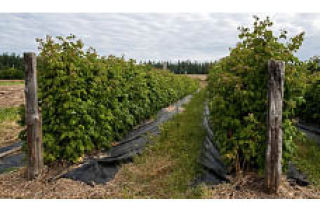Crowfoot Farm UPick raspberries will be ripe soon.
Most summers Crowfoot Farm owners Eric Hall and Elf Fay offer several weeks of UPick raspberries in the interval between their June and August strawberry crops. “The strawberries make a lull and the raspberries emerge out of that lull,” Eric explained as I talked with them earlier this spring. “But really,” they said: “we raise raspberries because we love them.”
If you love raspberries too and find yourself picking them at Crowfoot Farm in the next few weeks, here’s some raspberry back story to occupy your mind as your fingers fill your berry bucket.
The raspberries are Cascade Delight, a cultivar released in 2003. It was developed to withstand root rot, a condition that shows up in June as yellowed leaves and wilting plants but that actually begins in winter when roots that have reached down to moist clay subsoil in summer rot in winter when the clay fails to drain.
Eric described what he saw when he visited the agricultural experimental station that bred Cascade Delight: “It was just so awful looking, fifteen acres of the most sickly raspberries because they had purposely planted them in a root rot prone area. But then here and there was a raspberry that was doing beautifully. And that’s how they bred Cascade Delight.” Lucky for us that the cultivar emerged: most of our island topsoil rests on clay.
But the right variety is only part of the story. Look closely at where the berries are growing: at the tips of branches. As Eric explained: “The first year a raspberry plant makes a straight cane; the next year it makes branches and on the tip of every branch is the fruit, and then it dies. Meanwhile, while it’s branching and giving fruit, there are new canes coming up.”
How do Elf and Eric work with this life cycle? Ruthlessly! “In the winter, we cut out all the canes that bore fruit—you can see the branchy dead stuff—and all we have left are straight canes,” Eric said. “We keep the strong canes and cut out the weak ones,” Elf added. “I’m always afraid I’m cutting out too much, but it’s never a problem. We tie what’s left straight up on the wire in bundles of ten or so and cut them off at five feet.”
The thinning makes sense, but why the cutting? “The majority of the fruit is in the middle 60% of the cane,” Eric explained. “Because the cane that is left is getting all the water, I believe that the fruit that remains is better. And it seems to help the plants. It’s like thinning apples.”
And as for the raspberries themselves: how does a perfectly ripe raspberry get that way? “When berries themselves get sun, they have better flavor,” Eric said. Remember that thinning and pruning? But, “too much sun can cook raspberries. The kernels get white and opaque and the flavor is ruined.” Notice that Crowfoot Farm’s raspberries are in rows stretching north south, an orientation that distributes sunlight more evenly over the rows than an east west orientation. And notice the straw mulch and the irrigation lines. Raspberries need a lot of water along with the sun to develop flavor.
Finally, how can you tell if a raspberry is ripe? If it comes off in your hand when you touch it, it’s ripe. If you have to tug, it’s not.
And now you have a bucket of raspberries. What’s next? “They are awfully good in all kinds of desserts, but we just mostly eat them,” Elf and Eric said. And they freeze the excess, putting half full picking buckets right into the freezer and then, the next day, knocking out the berries which separate neatly and putting them in freezer bags for winter treats.
Whatever you do with your raspberries, now that you know more about them, maybe they’ll taste even better.



